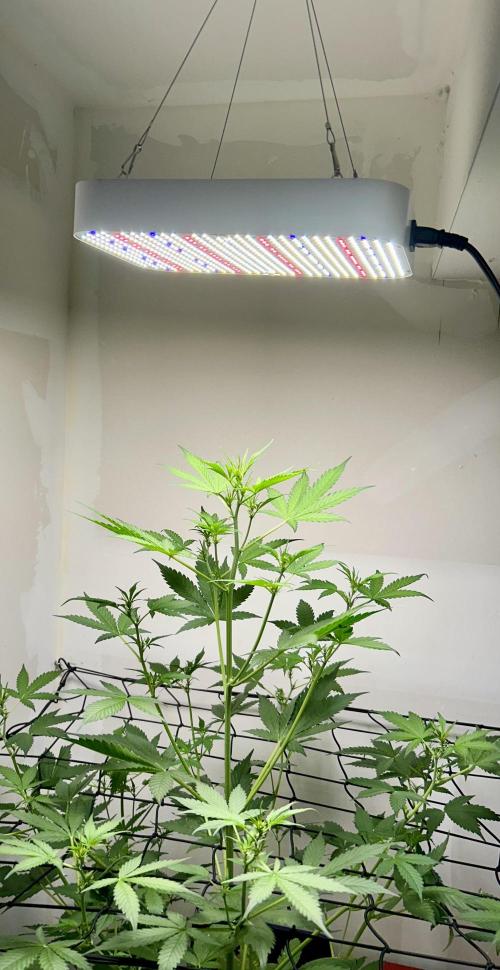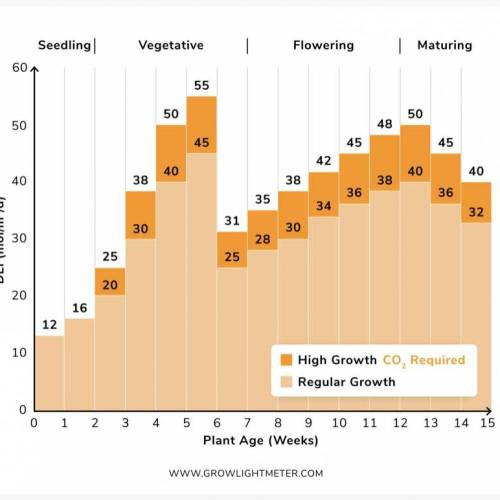By continuing to use the website or clicking Accept you consent to our cookies and personal data policy and confirm that you are at least 18 year old. For details please see Privacy Policy and Terms
Accept
Ideal DLI values ?
Dr_Drexxxstarted grow question 4y ago
Dear Photone and other light meter users, I’m just curious to know if you ever tried to apply these DLI to your grow ? https://growlightmeter.com/lighting-requirements-of-cannabis-over-the-full-grow-cycle/
I’m thinking about giving it a go for my new grow.
Open
Setup. Lighting
likes
Answer
NegotiatedBubbleanswered grow question 3y ago
Dr Bruce Bugbee's videos are a great source anything regarding PPFD, DLI, wavelength, etc. There's even a reddit AMA he took part in. Info gold.
likes
Complain
Ezzjaybruhanswered grow question 4y ago
I think those numbers are crap personally.. but go for it and see how it works.
You shouldn’t be cutting DLI in half when starting 12/12 IMO.
likes
Complain
Organomananswered grow question 4y ago
FMO, nothing more nothing less.
It will not make diddly squat difference to the average home grow.
They just want your money.
Better to concentrate on getting your feeding and watering right, this will affect your outcomes more than any photone app.
Focus on what you have, not on what you might have.
If you had a five acre indoor grow and were trying to minimise costs and maximise profits then these things would be useful, but for the average person growing at home with an average light, things like this are just designed to make your money, their money.
1 like
Complain
NobodysBudsanswered grow question 4y ago
"max" dli depends on numerous relativistic numbers...
does the app ask for area of coverage? if not i find it hard to beleive it is calculating DLI accurately.
temp, rh% and ambient co2 will all impact how much a plant can handle. these devices can still be useful. They inform about relative intensity under any 1 light... i'd be wary of comparing results between any 2 lights with different properties/characteristics.
So, you'll be relying on observing and reacting to plant... the measurement you take whether photone or lux will give a realtive intensity "mark" to follow in future under that light... any significantly different spectrum and you need to step through that process again.
important to measure in same exact spot and same exact distance... use a string or something similar and makr where it hangs fro for the measurement to be consistent... the rest of the coverage will be proportionally the same as before.
even with a real per meter, you still need to go through that trial and error with the plant to see how far you can push it.... your ambient environment will flcutuate if not tightly controlled, so be ready to back off or amp up over time as it will not always be the same.
Either case, these measurements will get you within a small distance fro optimal, but still have to react to the plant. the more tightly you control the environment and teh better the equipment (a real par meter in this instance) the smaller the ballpark you start in...
imho, don't spend hundreds on a real par meter, but also don't get sucked into an obvious llie... if it is free, use it like a lux meter, otherwise i'd buy a cheap lux meter. the sensor is better for a more true directional reading. phone lux meteres almost always exagerrate the value because your camera lense isn't made to do this well.
1 like
Complain
Similar Grow Questions
Solved

Chow_13
Stretch to the lightHow can you tell if your light is to close or to far? Is this gal stretching to much? Should I have increased the dimmer and/or lowered the light earlier?
Plant. Too short
Plant. Too tall
Setup. Lighting
5y ago
5
Solved

jimmminycricket
LightsUguguhrjrj is this enough light for these babez? 600 watt tamlampy
Setup. Strain - Autoflowering
Setup. Lighting
5y ago
2
3
Solved

DL_Jagger
RQ Runtz @ 6 weeks reaching within 10” of LED grow light. HeLP!Title probably speaks for itself. I really didn’t think it would be a good plan to bend the top which will be the future cola now ( or later)? This is the second day of week 6 for my Royal Queen seeds Runtz Auto grown in an Earth Box with an FRGrow 100 watt LED grow lamp. Any sug
Setup. Lighting
7d ago
2
5
Solved

Elendil
Led light powerI currently have 2 x marshydro ts1000. On what % should the dimmer be in week 2 ?Week 1
Setup. Lighting
5y ago
2
3
Solved

Growerxm00
18-6 or 24H Of lightHello growers, I’m growing an auto and I have it under 18-6 h and she already started to flower, my question is if I can change it to 24 h of light and if there’s any benefits with that, cause I already read that night time will help them recover a bit from stress and I use scrog5y ago
2
2
Solved

Listo
Light set up.My only question i have is about my light set up. My plants are 7 days today and i noticed that my plants are all facing towards the light. I have my light at 60cm from the top of the plants and 75% on the dimmer. The light is also 1000 Watts. The tent size is 4x4.
Setup. Lighting
4y ago
1
Solved

Percy
Marshydro ts600 for a 50x50x100Hi quick question,
Purchasing 50x50x100 tent
Will the marshydro ts600 be ideal for this yes just shy of 2x2.
Im aware the ts1000 is better and has dimmable option but wouldn't that be too powerful for my little 2x2 with a height if only 100cm? Will be from (marshydroled.co.uk)
Setup. Lighting
Setup. Ventilation
4y ago
3
5
Solved

chrisg79
LightingAny help on my light Question in comment would be really appreciated. TIASetup. Lighting
5y ago
3
2
Solved

XXCYPR3SSRAG3XX
Hey everyone just found out that my grow light only puts off 15000lux and my girl are really behide so i just put them outside and i want to find the best led grow light for veg and flower my tent is 4ft×4ft×6.5 ft i think it's was vegetable light plz helpSetup. Lighting
5y ago
1
6
Solved

MoWax
When will the plant be good?..Hi! I am a beginner grower. I converted a refrigerator for micro-growing. How long until my first plant is finished? It grew semi-open air. The box was ready a few weeks ago and I put it in. My lamp is viperspectra p600. I welcome any useful advice. Thanks.
Buds. Other
Plant. Other
Setup. Lighting
2y ago
2
2
Solved

Sugahmama
OMGMy Timer malfuntioned and gave them over 22 hrs of light?I was wondering why they kept growing this fast and big until i controlled the system and noticed they get to much light and stretching this hard. So i turned the hrs down to 16 to stress them into blooming, will this Work?
2y ago
7
7
Solved

jimmminycricket
Can anyone recommend me a good led under 250$ thank yaPlant. Other
Setup. Strain - Autoflowering
Setup. Lighting
5y ago
1
2
Solved

GlockAbuser
Is this a sign of too much light?I’m noticing the leaves grow extremely close to each other, should I be concerned at this stage, should I pull the light higher back? This is day 3 of week 2, I’m feeding it full advanced nutrients line up for veg. And drying out for a day and a half between waterings
Week 2
Setup. Lighting
2y ago
2
3
Solved

TheGuyNextDoor
HPS to LED LightsHi guys, looking to start using LEDs. I am currently using 400W HPS lights. I'd like to be using 600W but the room simply gets too hot. I am looking at LED lighting but unsure of what LEDs to go for. As I am using 400w/600w HPS what LED would be like for like replacement? Thanks
Setup. Lighting
5y ago
1
10
Solved

HiddenMessage
Do watts from light matter just as much in veg as flower?Week 1
Setup. Lighting
5y ago
2
Solved

Jeffrokush
New light ! Migro Aray 4 ! Lol I’m Still a noob.Actually I need to change my info , I got a newer light ! Migro aray 4 but my question was what distance away or better yet what par range should I be using when in veg ? I have the toy gauge in the pot saying the lights intensity is at 850-900 par…
Week 6
Setup. Lighting
4y ago
1
3
Solved

ohighoan
LED light flickers during lights out. What is my best option?Found out my light is flickering during lights out, not bright enough to see the plants but I could see the light. could I have stressed them enough to hermie? Should I wait a bit longer to flower?
Week 10
Setup. Lighting
3y ago
1
3
Solved

connormcleod47
What is the optimal uMOL/DLI for autoflowers during the flowering cycle without CO2 on a 20/4 schedule?Setup. Lighting
8mo ago
3
3









